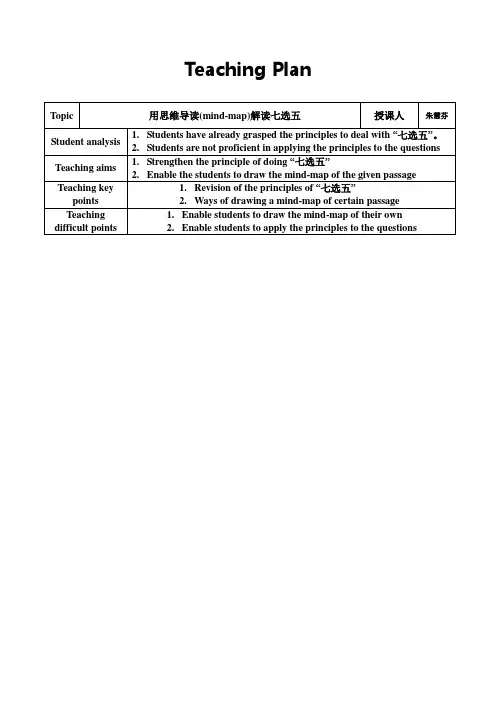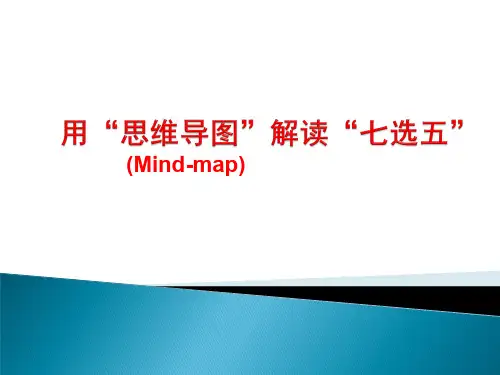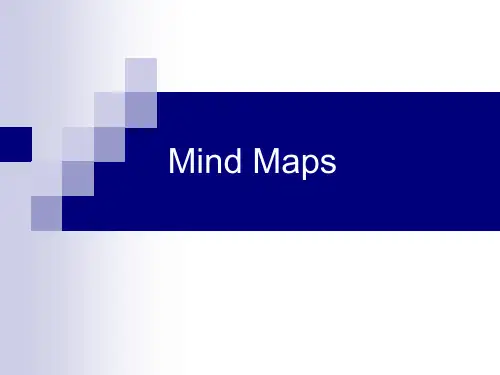深圳优质课件 英语备考用“思维导图mindmap解读七选五
- 格式:ppt
- 大小:2.24 MB
- 文档页数:45





巧用思维导图解高中英语七选五摘要本文针对高中英语七选五阅读题型进行研究,提出了运用思维导图作为一种解题策略的可行性与有效性。
本研究不仅为高中英语教学提供了一种新的解题思路,还为学生在处理复杂信息和建立逻辑关系方面提供了实用的工具。
关键词:思维导图;高中英语;七选五;阅读理解;解题策略引言:在高中英语教学中,七选五题型作为一种常见的阅读理解题,对学生的综合语言能力有着不小的考验。
但许多学生在解决这类题目时感到困惑和挫败,主要问题在于如何快速而准确地从多个选项中找出最合适的答案。
本文的目的在于探究一种新颖而有效的解题方法——利用思维导图来解决七选五题型。
思维导图不仅帮助学生在短时间内整理和处理信息,还有助于形成更为清晰和逻辑严密的思维方式。
一、思维导图:定义与基本特点思维导图是一种将抽象的信息转化为可视化图表的方法,旨在帮助人们更有效地吸收、组织和表达知识。
与传统的笔记方式相比,思维导图具有空间结构,能更好地描绘信息间的关联和层级,因此在教育、商业和个人规划等多个领域都有广泛应用。
重要的是,思维导图与大脑的工作方式高度契合。
大脑并不是按照线性或文本的形式来处理信息,而是在不同观念间建立连接。
这一点正是思维导图强调的:通过图形、颜色和空间布局来模拟人类大脑对信息的自然处理方式。
这种可视化的优势让思维导图在高效整理和梳理复杂信息时具有明显优势。
在教育领域,尤其是高中英语教学中,思维导图的这种优势被赋予了特殊的意义。
高中生面临众多学科的学习任务,信息量大,压力也相对较大。
在这种情况下,需要一种能够快速、准确地帮助他们吸收和理解信息的工具,而思维导图正好满足了这一需求。
尤其是在处理七选五这种需要高度集中、筛选和判断的题型时,思维导图能够帮助学生迅速地看出文段与选项间可能的逻辑联系,减少错误选择的可能性。
同时,思维导图在教学过程中的应用也不应被忽视。
教师可以在解题策略的讲解过程中,运用思维导图来明确解题步骤和注意事项,让学生在形象的图表中看到答题的“路径”,从而更容易掌握和应用。






以思维导图解读七选五蔡尔茵 2019/05/08Teaching Aims:(1)Knowledge and Ability : Get students to use mind-map to main idea, structure and logicalrelationship between sentences in texts with gaps(2)Process and Method: Observation, Conclusion and Practice(3) Emotion, Attitude and Value: a: Encourage students to be confident in doing “the reading cloze” b: Encourage students to improve their skills in doing “ thereading cloze”Teaching Difficulties and Important Points:a: Enable students to know about how to make a correct mind-map about texts.b :Guide students to observe and sum up the strategies used in “ the reading cloze”c :Get students to apply what they have learnt to the practice.Teaching Produces:StepI: Lead-Ina : Show videos which is shot by two students who are good at this question to the whole class, sharing their experience.b ; sharing methods: according to the exercises done by students last night, they conclude some strategies about how to do.Step II: Presentation(Take a passage from the exam paper for an example)B: Mind-map about the relationship between sentencesStepIII: PracticeTeam WorkPassageSwimming, cycling, jogging, skiing, dancing, walking or any of dozens of other activities can help your heart.1.Whether it is a structured exercise program or just part of your daily routine, all exercise adds up to having a healthier heart. Here are some tips for exercise success.●Choose activities that are fun and add variety. Develop several activities that you can enjoy.2●Wear comfortable, properly fitted shoes and comfortable, loose-fitting clothing appropriate for the weather and the activity.●Find a convenient time and place to do activities.3. If you miss an exercise opportunity, work activity into your day another way.●Use music to keep yourself entertained.●4.Decide what kind of support you need. Do you want them to remind you to exercise? Exercise with you regularly or occasionally? Be understanding when you get up early to exercise? Spend time with the children while you exercise? Try not to ask you to change your exercise routine? Share your activity time with others. Ask your family members, friends or co-workers for help.●Don’t overdo it, especially at first. You can slowly increase the time and intensity (强度) of your activities as you become more fit.5●Keep a record of your activities. Reward yourself at times. Nothing will inspire you more than success!(Let students finish the mind-map through cooperation, and show the result to the whole class, at last choose the best one)StepIV: SummarySummarize the skills about how to do this question.StepV: HomeworkDo the mind-map about the passage on the book 感谢您的阅读,祝您生活愉快。
用思维导读(mind-map)解读七选五Teaching Plandifficult points 2.Enable students to apply the principles to the questions Step 1. Revision(1)Introduce the idea of mind-map(2)Using a mind-map to review the principles students have learnt before(3)Review the choices appeared in “七选五”Step 2. Input: Example mind-map drawing(1)Read the example passage together(2)Find out the topic of the example passage(3)Analyze the passage sentences by sentences(4)Summarize the key words of each sentence(5)Draw the mind-map step by step(6)Compare the choices and work out the answers one by one according to themind-mapStep 3. Output: draw a mind-map according to the example map.(1)Read the passage in groups(2)Discuss the topic of the given the passage(3)Draw the mind-map on the whiteboard’(4)Work out the answers togetherStep 4. Peer-evaluation(1)Students evaluate the mind-maps from the other groups(2) present the reasons why they like the mapStep 5. Teacher evaluation(1)Teacher comment on the mind-map chose by the students(2) show the example map drawn by teacherStep 6. Homework(1)Draw a mind-map of the passage on P69(little yellow book)(2)Work out the answers to the questions.。